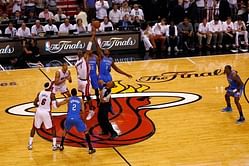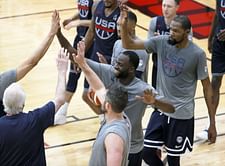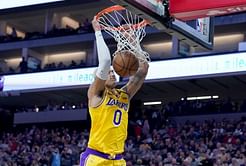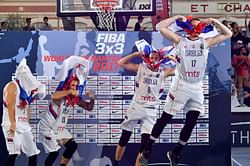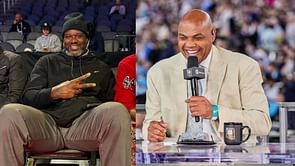If you are to look up information related to basketball rules, then, there will be hundreds of things you may come across which are hardly encountered in daily tournaments. So this article aims to make you aware, without any confusion, regarding the basic basketball guidelines and the NBA rules.
This is indeed a complicated topic, not only because there are so many rules in basketball, but also because these rules change depending on where we are playing the game. For example, the regulations in the FIBA (International) games differ from those followed in the NBA. Until 2000, FIBA used a 30-second shot clock as compared to the NBA's 24-second shot clock.
Who invented Basketball?
The popular game of basketball which we know today was invented by a Canadian physical instructor by the name of Dr. James Naismith in 1981. Dr. Naismith who was working at the YMCA International Training School in Springfield, Massachusetts was tasked of thinking of an indoor sport that would keep the YMCA athletes in good shape. This requirement came about as the winters in Massachusetts are quite harsh and as such outdoor activities can be difficult to partake in.
Interestingly, this challenge was handed out to various faculty members by Luther Halsey Gulick, the superintendent of physical education at the college. Dr. Naismith took up the request and put a lot of thought and effort into developing a game that would be simple enough to play yet complex enough to retain the interest of players. He borrowed many aspects from other sports such as passing (American Rugby), jump ball (English Rugby), shape and size of the ball (Soccer), and the use of a goal (lacrosse).
What is Basketball and its Rules
1) Basketball is a game in which five players from each team play at a time on the basketball court.
2) The players aim to score a basket by putting the ball inside the hoop elevated 10 ft above the ground.
3) The team with the ball in possession is the team on offense, and the opposition is the team on defense.
4) Once the offensive team has the ball, they have 24 seconds on the shot clock to shoot it toward the basket. If the offensive team either fails to shoot the ball or fails to touch the rim or make the shot, a 24-second shot-clock violation is granted to the offensive team, resulting in a turnover. The shot clock was introduced in the NBA in 1954.
5) If the offensive team fails to bring the ball up the court (beyond their backcourt) within eight seconds, an 8-second violation is called, resulting in a turnover.
6) There can be a total of 12 players on the team roster, but only five can play at a time.
7) The game of basketball consists of four quarters of 12 minutes each, and if scores are tied at the end of it, there is a five minutes’ extension called “overtime”.
8) The scoring rules are simple. If you shoot from behind the arc, you will get three points whereas shots from inside the arc earn two points. Also, each free throw is worth a single point.
9) There are a variety of ways to score 1, 2, 3, or 4 points on a single possession. For eg., While any shot within the three-point arc is considered to be worth 2 points, if the shooter is fouled during the upward motion of the shot, and the shot goes in, then the basket counts and the player gets a chance at an And-1 by getting one free throw as well. The shooter is granted 1 free throw (worth 1 point) and if the shooter makes the free throw, a three-point play is said to be completed. Similarly, if the player is fouled during a three-point shot and the shot goes in, he gets a chance at a four-point play.
10) Each team has a fixed number of team fouls, and each player has a fixed number of personal fouls. Exceeding the team foul limit (5 per quarter in the NBA) results in bonus free throws for the opposing team while exceeding the personal foul limit (6 per game in the NBA) results in the ejection of the said player.
11) A player playing on the court can be substituted from the players on the bench by the coach. A coach can make an unlimited number of substitutions throughout the game.
Read more about NBA Schedule
What are the 13 original Basketball rules?
Dr. Naismith, the inventor of the game of basketball came up with a list of 13 original basketball rules which are as follows:
1) The ball can be thrown with one or both hands in any direction.
2) Players cannot run with the ball, they must throw the ball from the spot that they catch it. Some leeway was granted for a player catching the ball while running if he tried to stop.
3) The ball must be held between the hands. Holding the ball between the arms and legs is not permitted.
4) The ball can be batted in any direction with one or both hands but not with the fist.
5) Shouldering, holding, pushing, tripping, or striking the opponent in any way is strictly prohibited. The first infringement of this rule results in a foul while the second one disqualifies the player until the next goal is made. If there was any intent on injuring the opponent, then no substitutions for that team were allowed for the rest of the game.
6) Striking the ball with a fist results in a foul.
7) If either team were to make three consecutive fouls, then the opponent receives one goal (in this case consecutive means that the opponents do not foul in between).
8) A goal is counted if the ball is thrown or batted into the basket and it stays there as long as those defending the goal do not touch or disturb the goal. If the opponent moves the basket while the ball is resting on the edge, then a goal is counted.
9) Once the ball goes out of the play area, the first person to touch it gets to throw the ball in the field of play. If there is any dispute, then the umpire throws the ball in the field of play. The player throwing the ball inside shall not hold it for longer than 5 seconds, or else the ball goes to the other team.
10) The umpire shall be the judge of the players and shall notify the referee when three consecutive fouls are made. The umpire also possesses the power to disqualify players.
11) The job of the referee is to judge when the ball is in play, when it has gone out of bounds, and to which team the ball belongs. the referee must also keep a check on the time. He shall also decide when goals are made and count the number of goals along with other duties deemed fit to be undertaken by a referee.
12) The game's duration shall be two halves of 15 minutes with a rest period of 5 minutes between both halves.
13) The winning team is the team making the most number of goals. In case the game ends in a draw, the team captains can mutually agree upon playing further till another goal is made.
FAQs
Q. What are fouls in basketball?
A. A personal foul in the game of basketball occurs when a player's actions against an opponent causes illegal contact.
A. A personal foul in the game of basketball occurs when a player's actions against an opponent causes illegal contact.
Q. How much time is the shot clock in the NBA?
A. In the NBA, teams have a shot clock up to 24 seconds before which they need to shoot the ball.
A. In the NBA, teams have a shot clock up to 24 seconds before which they need to shoot the ball.
Q. For how many seconds can you hold on to the ball?
A. A player may hold on to the ball for a maximum of 5 seconds. If a player is guarded then he must start dribbling, pass the ball, or shoot it within the stipulated time of 5 seconds.
A. A player may hold on to the ball for a maximum of 5 seconds. If a player is guarded then he must start dribbling, pass the ball, or shoot it within the stipulated time of 5 seconds.
Q. How long is a typical NBA game?
A. A typical NBA game's play time last for 48 minutes. It consists of 4 quarters of 12 minutes each.
A. A typical NBA game's play time last for 48 minutes. It consists of 4 quarters of 12 minutes each.
Q. How long is the halftime break in the NBA?
A. Teams get a halftime break of 15 minutes in the NBA.
A. Teams get a halftime break of 15 minutes in the NBA.
